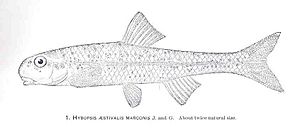Speckled chub facts for kids
Quick facts for kids Speckled chub |
|
|---|---|
 |
|
| Conservation status | |
| Scientific classification |
The speckled chub (Macrhybopsis aestivalis) is a small freshwater fish. It belongs to the Cyprinidae family. This family also includes well-known fish like carps and loaches.
Contents
About the Speckled Chub
Speckled chubs have a thin, somewhat flat body. They are usually yellowish-tan or silver. Sometimes, they have dark spots. Their belly area is mostly silver.
Body Features
Their eyes are set high on their head. The lateral line on their side has 34 to 41 scales. This line can look straight or curved. The top fin, called the dorsal fin, has soft rays with slightly dark edges.
Their mouth is flat and on the underside of their head. They have long whiskers, called barbels, at the corners of their mouth. Their snout is rounded with soft lips.
Fin Details
The speckled chub has several fins:
- Less than 10 soft rays on its dorsal fin (top fin).
- 16 to 21 soft rays on its caudal fin (tail fin).
- 7 to 9 soft rays on its anal fin (bottom fin near the tail).
- 6 to 9 soft rays on its pelvic fin (fins on the belly).
- 11 to 18 soft rays on its pectoral fin (fins on the sides).
They also have pharyngeal teeth, which are teeth in their throat.
Size and Lifespan
The biggest speckled chub ever recorded was about 7.6 centimeters (3 inches) long. On average, they are about 6.1 centimeters (2.4 inches) long. These fish usually do not live longer than one and a half years.
Where Speckled Chubs Live
The speckled chub is originally from North America. You can mostly find them in the United States and Mexico.
Their Home Rivers
In the U.S., they live in the Mississippi River basin. This area stretches from Minnesota and Nebraska down to West Virginia and Ohio. They are also found in rivers that flow into the Gulf Slope from Florida to Texas and New Mexico.
Preferred Habitat
These fish like to live in large, flowing rivers. They stay near the bottom where the water moves at a moderate to fast speed. They prefer areas with sandy or gravelly riverbeds.
What Speckled Chubs Eat
Speckled chubs have special taste buds. These taste buds are on their head, body, and fins. They use them to find the aquatic insects they eat.
They mostly feed on insect larvae that live in the water. A big part of their diet includes the larvae of midges.
Reproduction and Life Cycle
Speckled chubs lay their eggs, a process called spawning, around midday. This happens from late April to August.
Spawning Locations
Large groups of these fish gather to spawn. This happens in the lower Pearl River in Mississippi during March and April. They also spawn in the main parts of the Cahaba and Tallapoosa Rivers in May and June.
Mating Behavior
These fish have external fertilization. This means the eggs and sperm meet outside the female's body. Mating starts when a male chases a female and gently nudges her belly. When the female is ready, the male wraps himself around her. Then, both eggs and sperm are released at the same time. This process usually repeats several times. There are often at least ten minutes between each time they release eggs and sperm. The speckled chub does not protect its eggs from other animals that might want to eat them.
Conservation Status
The speckled chub is considered a threatened species in Mexico. However, they are quite common in the main part of the Rio Grande river.
Population Decline
The number of speckled chubs has gone down in the lower Rio Grande. This is due to several reasons:
- reservoirs (dams that create lakes)
- Channelization (making rivers straighter or deeper)
- Less water flowing in the streams because of irrigation (watering crops).
Why They Are Called Speckled Chubs
The speckled chub gets its name from the black spots on its body.
Scientific Name Meaning
The "macr-" part of its scientific name, Macrhybopsis aestivalis, comes from a Greek word meaning "long." This likely refers to the long, thin bodies of fish in the Macrhybopsis group. The "aestivalis" part means "pertaining to summer." This refers to the long period during which the speckled chub lays its eggs.
See also
 In Spanish: Macrhybopsis aestivalis para niños
In Spanish: Macrhybopsis aestivalis para niños


